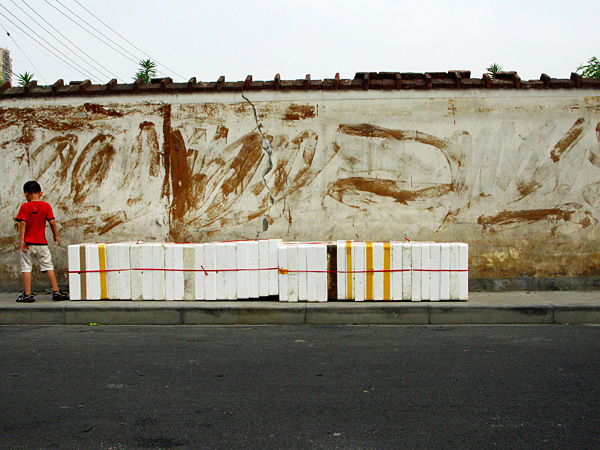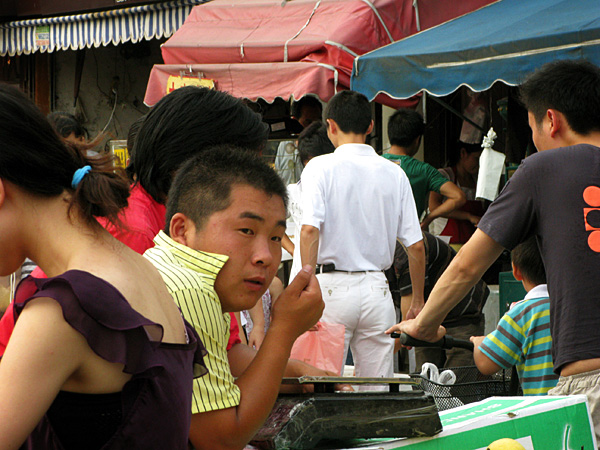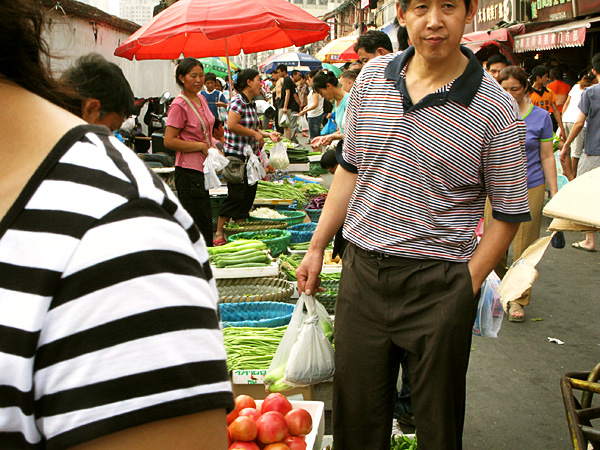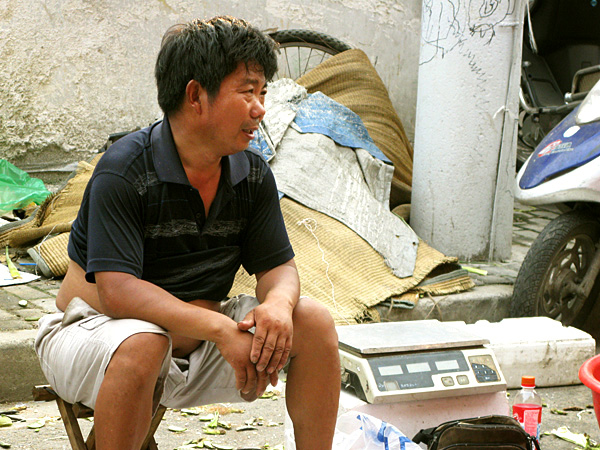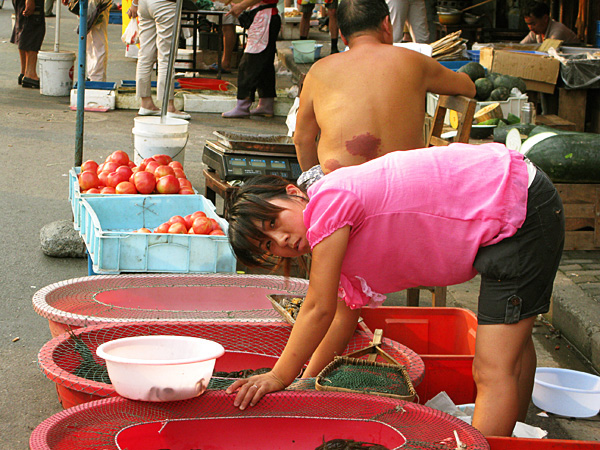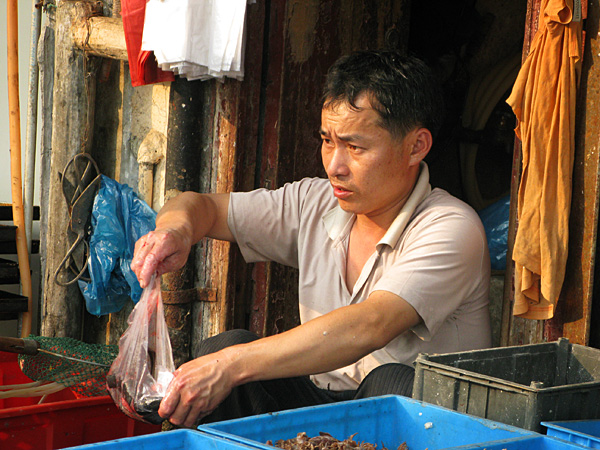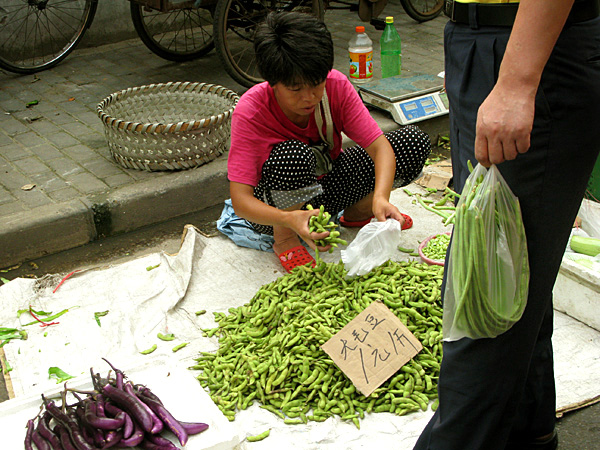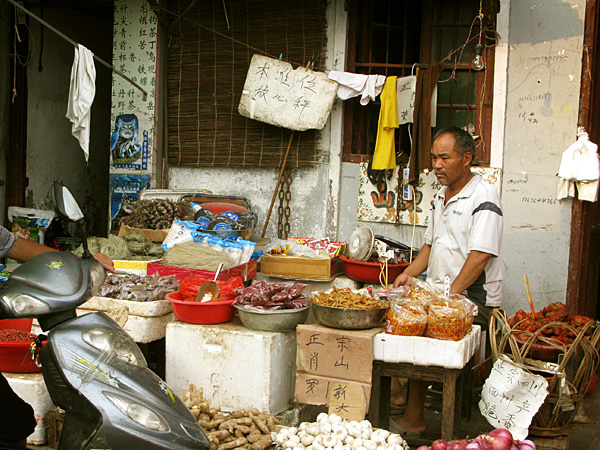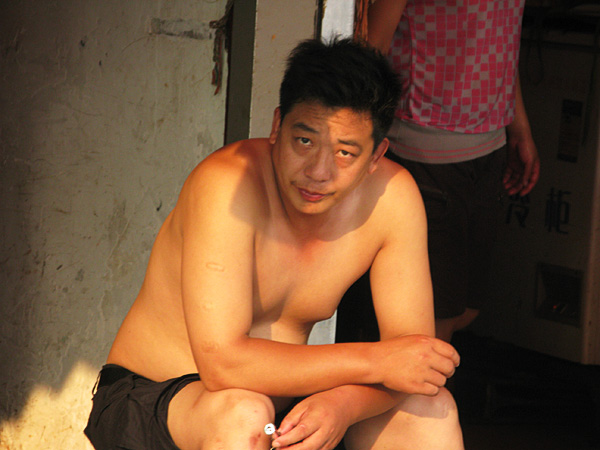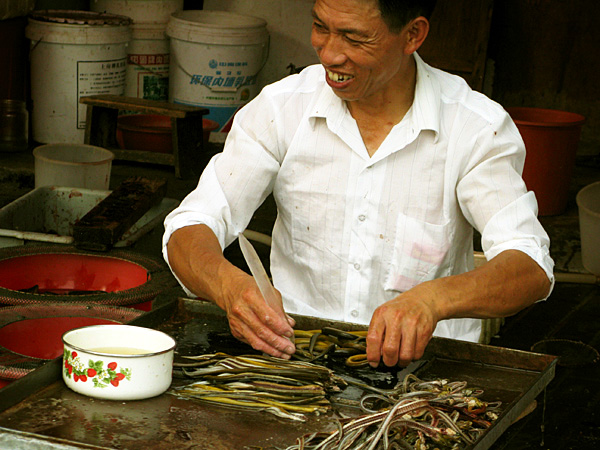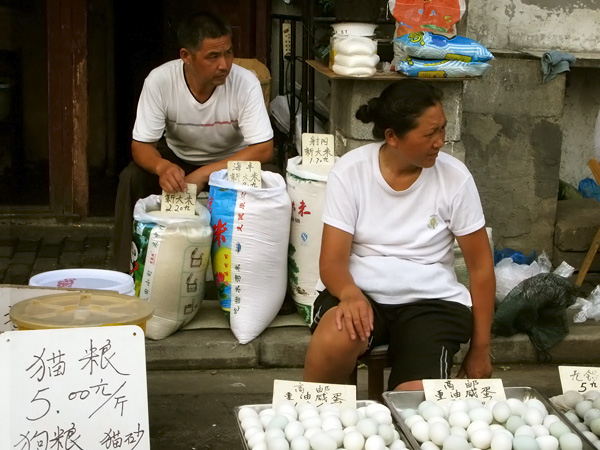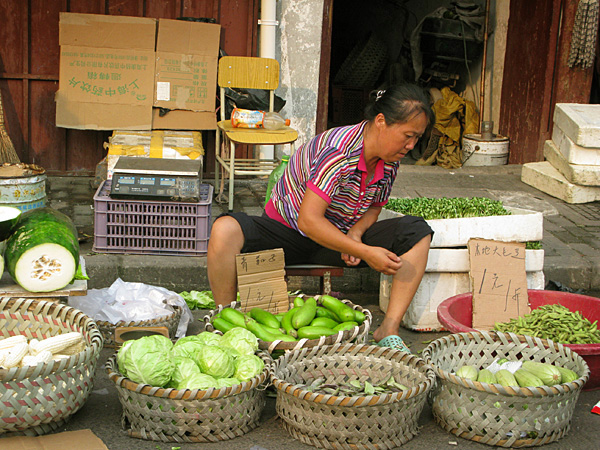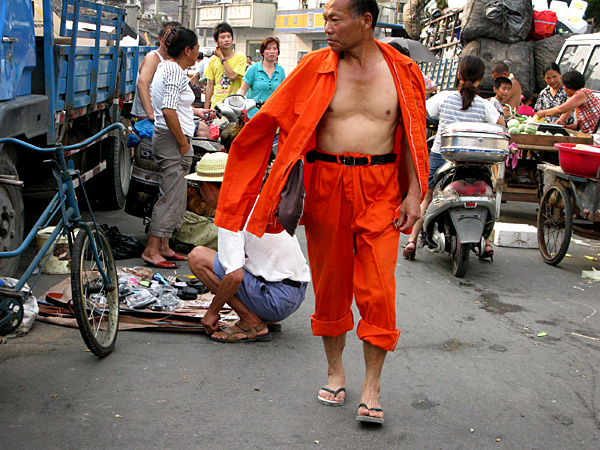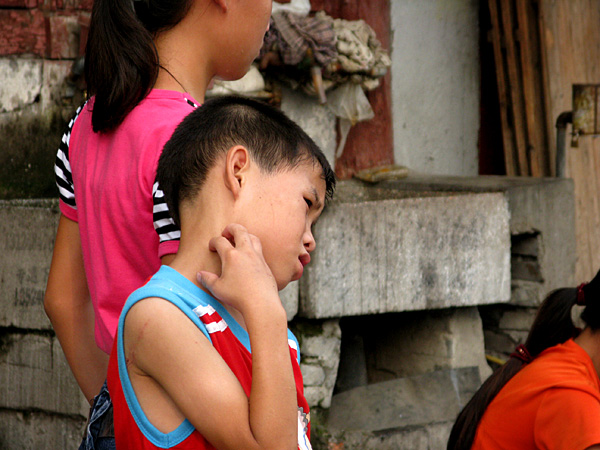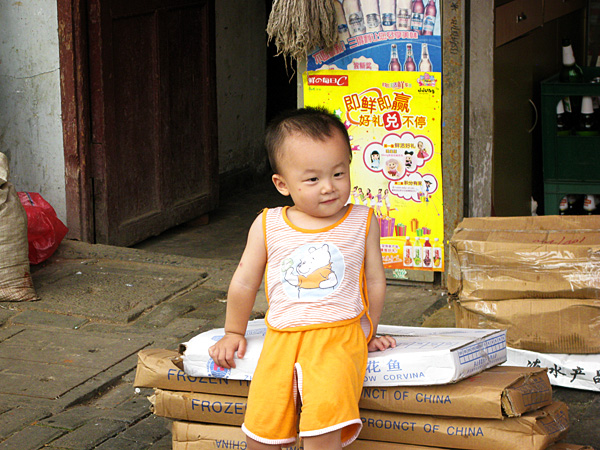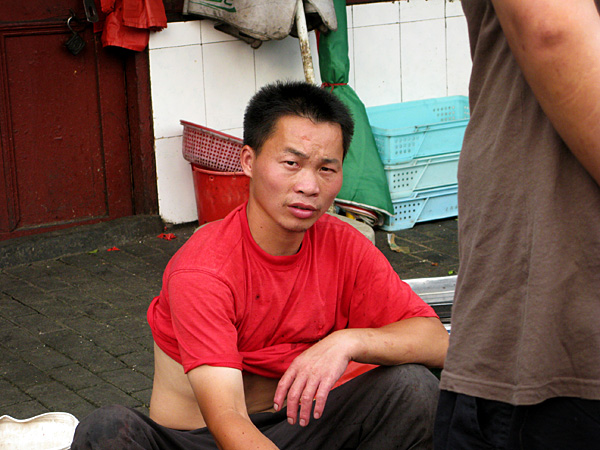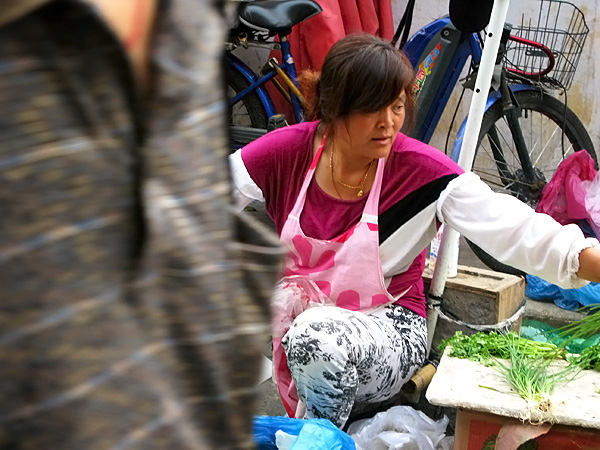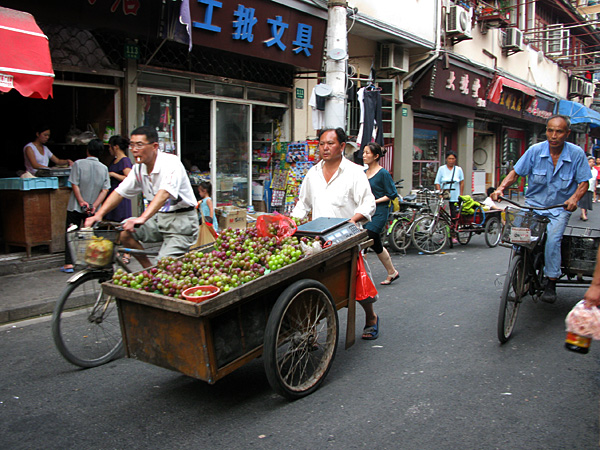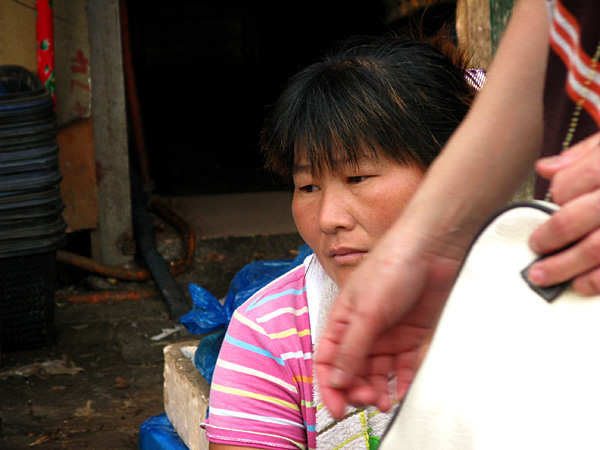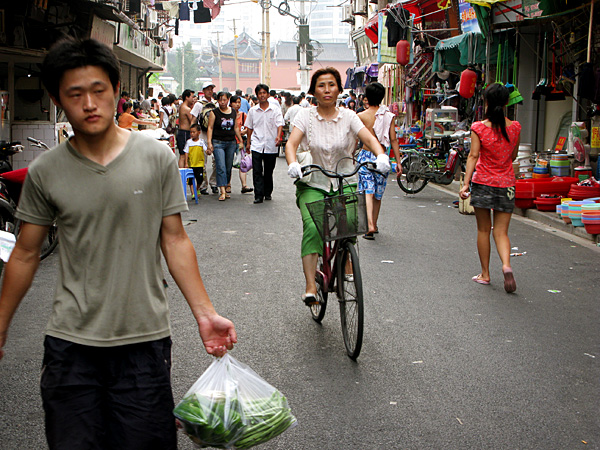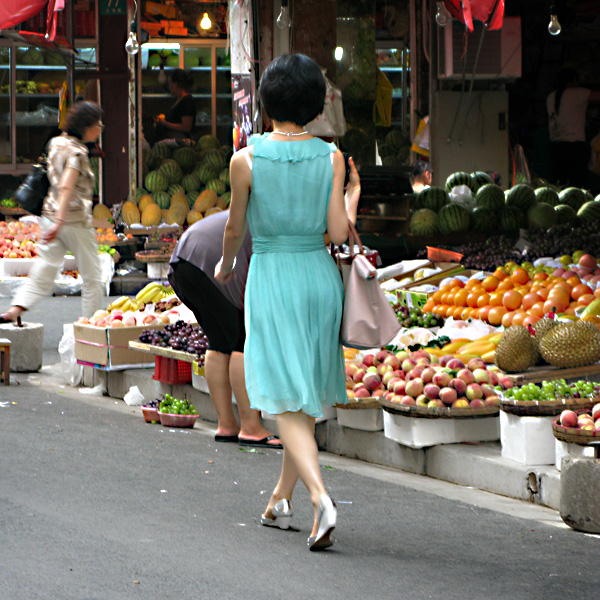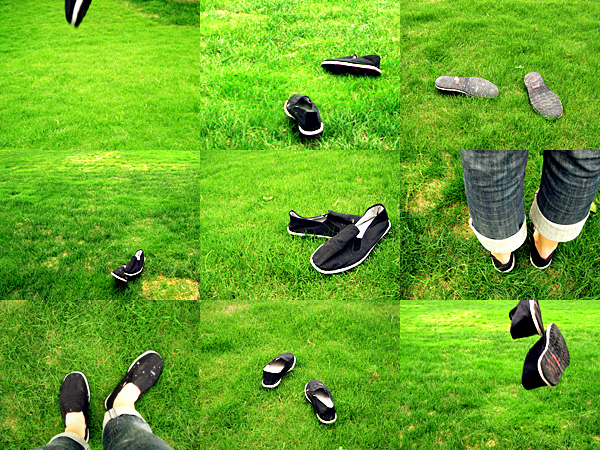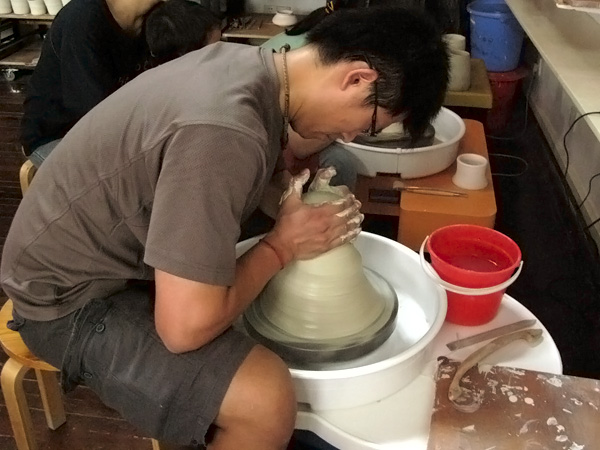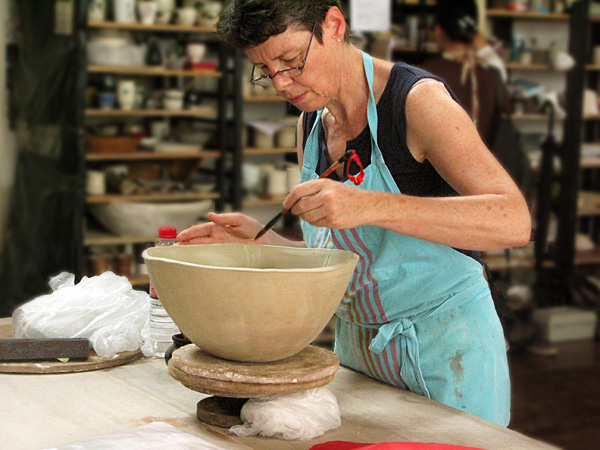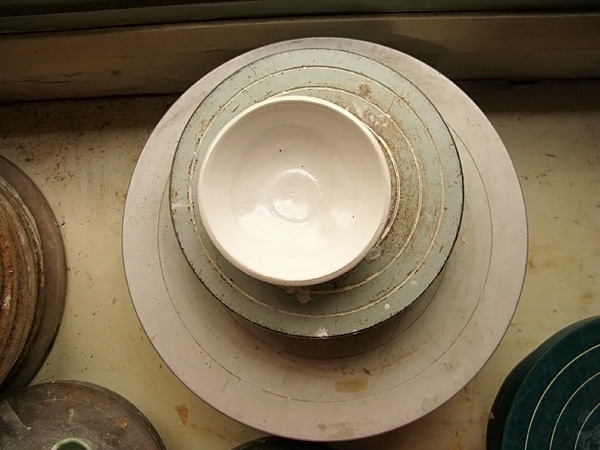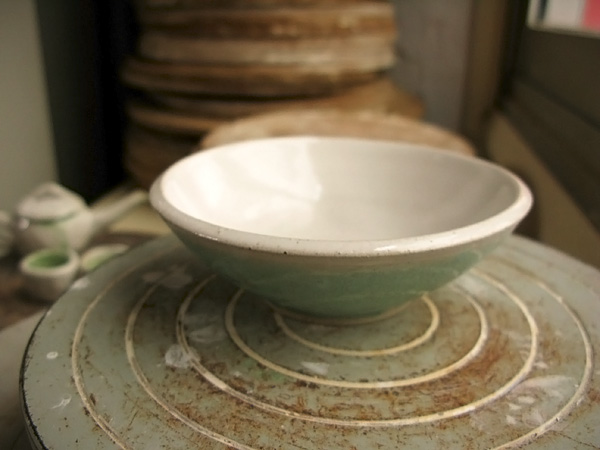Jingdezhen: Making Pottery
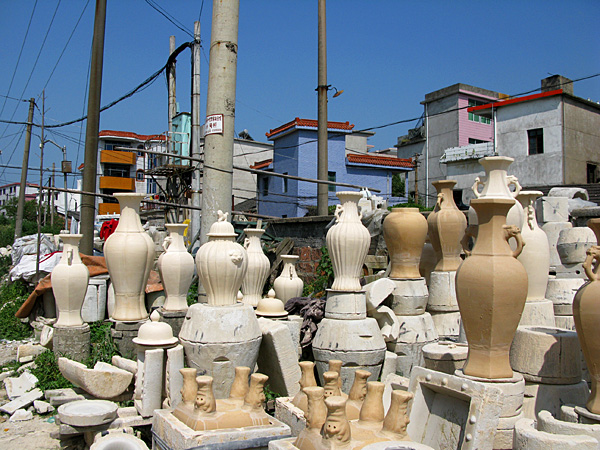
Would you like a city with your pots?
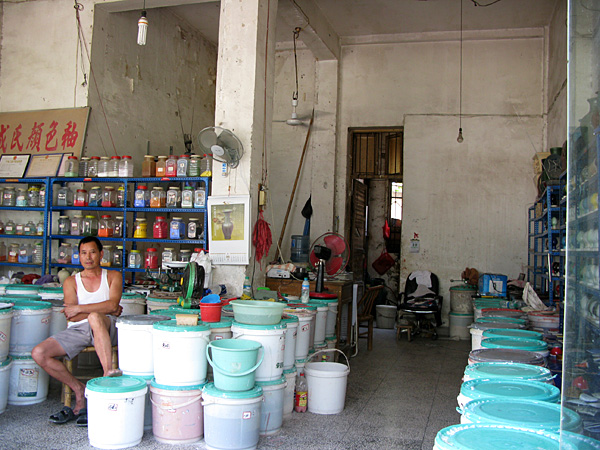
One of many Glaze Shops
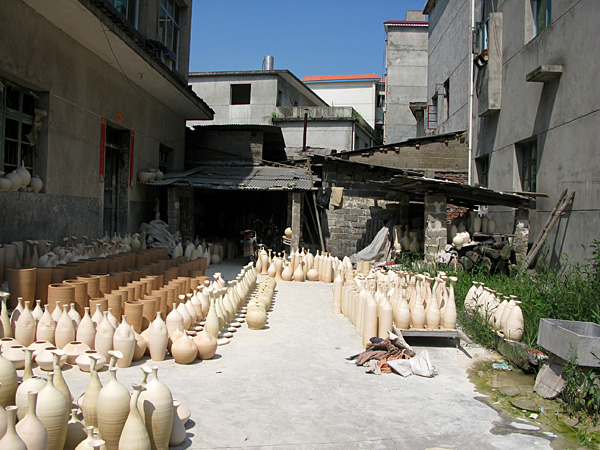
Courtyards filled with drying work
I’ve wanted to go to Jingdezhen ever since I heard about it a month or so ago from my ceramics teacher at the Pottery Workshop (PW for short because I’ll be mentioning it a lot in this post). He described it as a great place for potters to spend weeks or months, but everyone else would be happy going for a day or two. At the time, I had dreams of going for a month and doing a residency, but I quickly realized that I don’t have the skills or creative vision yet to make it worth my while. That means I was up for the “day or two” trip, and I figured I might be able to rope Nik into going with me. At first he didn’t seem to excited about, then I found this blog post on Extreme Craft that included a video of two guys throwing this enormous pot, and after that, Nik was hooked!
In the “no time like the present” mentality, we decided last Tuesday that we would go the following Saturday. We only had the 48-hour weekend, so we had to forgo train travel for air travel to make the most of our time. (16 hours; 150rmb/$22 each way vs 1 hour; $83 each way) Flights from Shanghai Honqiao (SHA) to Jingdezhen Luojia (JDZ) leave once a day at 8:45am and return once a day at 9:20pm. Perfect for a weekend.
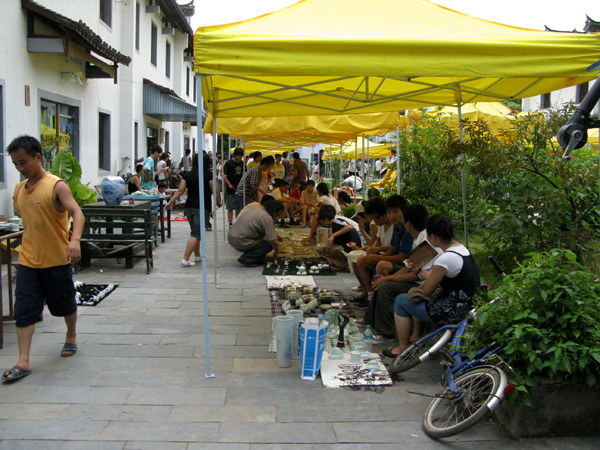
The Pottery Workshop Saturday morning Student Market
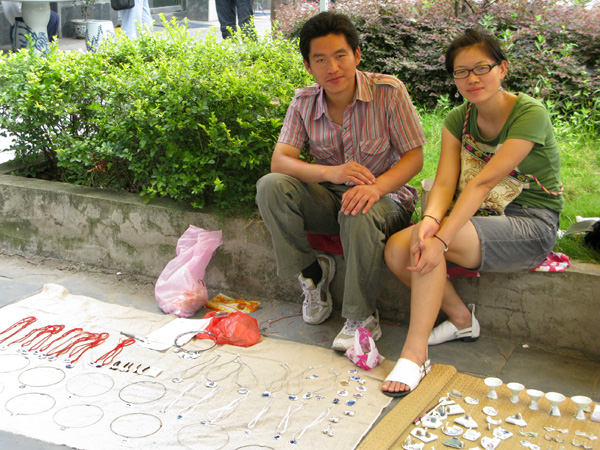
Students selling pieces at the Saturday morning market
Once transportation was taken care of, I took my own advise from the “Boarding Pass” interview I did over on Prêt à Voyager a few months ago and contacted some people that had been in the city for a while that could give us some tips on what to do. First, I contacted Derek, who runs the artists’ residency program at the PW there in Jingdezhen. He emailed me back with a great list of places around town (including Chinese characters for the taxi drivers) and told me about the student market they have every Saturday morning at The Sculpture Factory as well as mentioning that they have a cafe with good coffee! It really is amazing how helpful just one little email can be. Based on his recommendation, we knew exactly what our first step would be when we arrived, AND we knew where we could find a good cup of coffee!
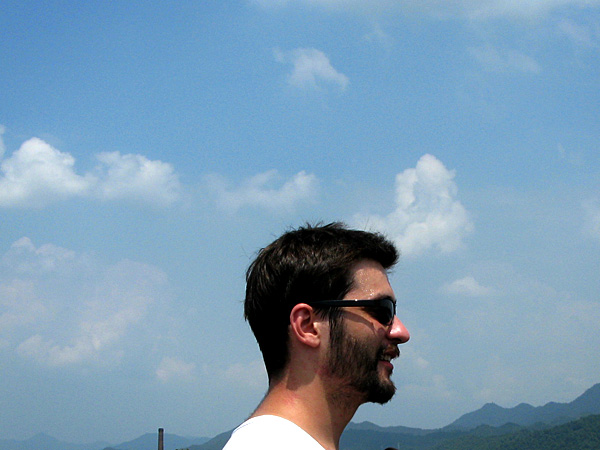
Patrick...our unofficial guide to Jingdezhen!
I also contacted Patrick, who is in Jingdezhen for the summer while he is working on his masters degree in ceramics at the University of Florida. I thought he was a resident artist at the PW, but it turns out that he is actually a staff member that teaches classes and works in the design studio during the week. This means he’s being paid to be in this amazing ceramics environment while learning so much about the production process. You can’t get much better than that! In our email exchanges, we planned on having dinner on Saturday night, but we ended up running into him while were walking around the student market and he offered to show us around The Sculpture Factory right after lunch. He walked us through the design studio and explained a lot of things about production pottery that I never understood and showed us a few of the projects they are working on. The big thing about the Design Studio at the Pottery Workshop is that they capitalize on their connections to the talent and resources found in Jingdezhen to help designers from all over the world produce custom pieces on a smaller scale while they monitor the quality. It’s kind of hard to explain, but it’s a great concept, so if you’re interested, click here. I plan on having all of my breakfast ware for my B&B made here!!
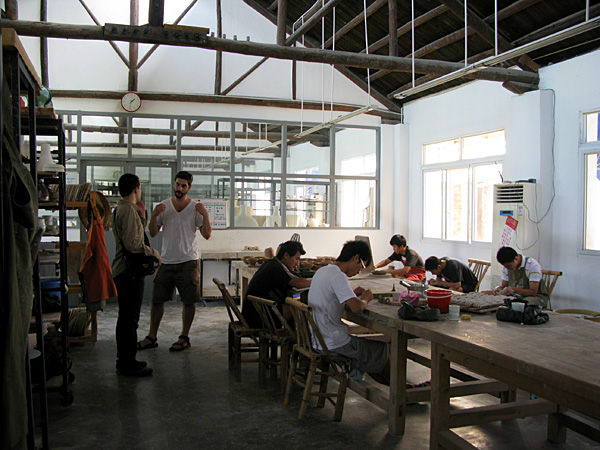
The Pottery Workshop design studio
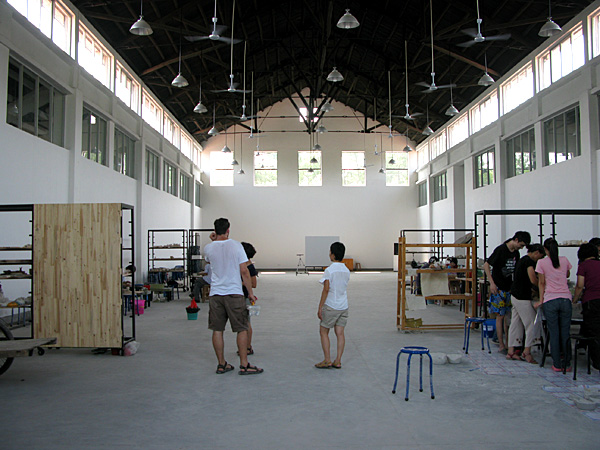
The Pottery Workshop 2 Chimneys building
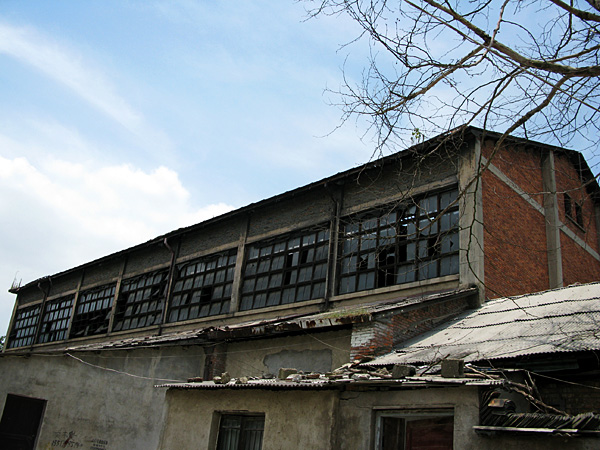
One of "The Sculpture Factory" buildings
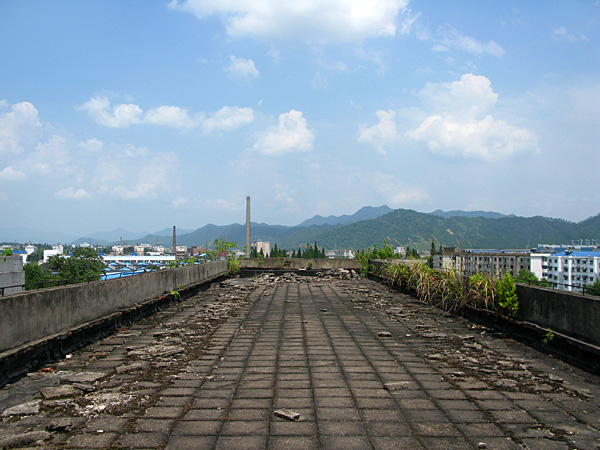
The Sculpture Factory: A rooftop view
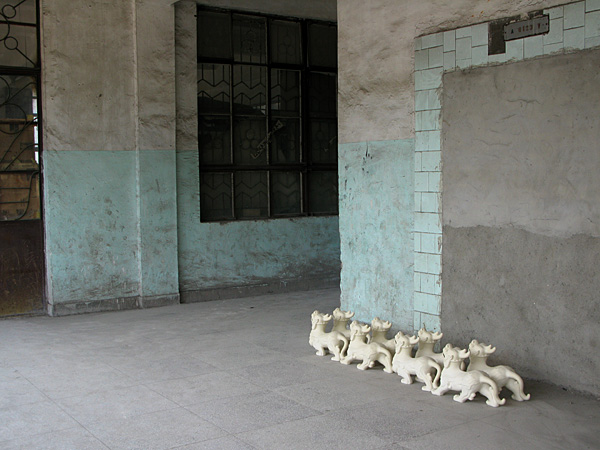
Lions Marching
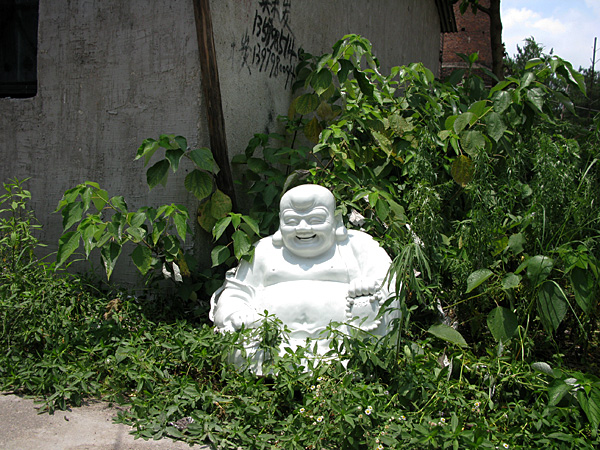
Happy Buddha
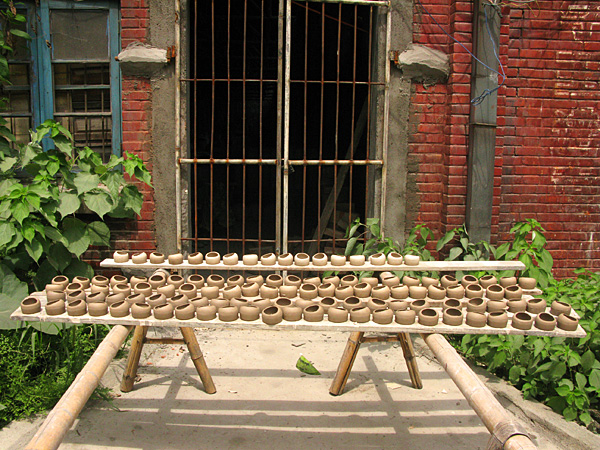
Small irregular pots
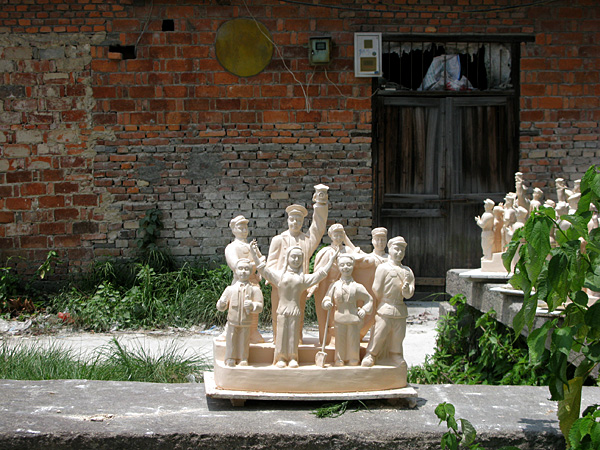
Statuettes standing among friends
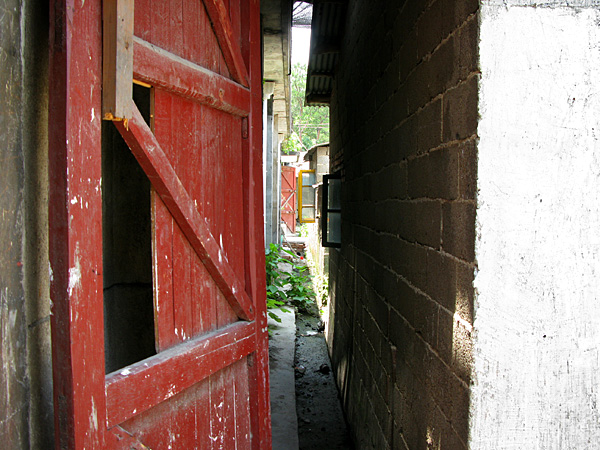
Between Buildings
The Pottery Workshop has a very impressive modern “campus” situated in the middle of one of the old factories east of downtown Jingdezhen. Unfortunately, I didn’t get very many good photos, but if you’re planning a trip to this city, I recommend that you make it your first stop. The cafe does have wonderful coffee as well as tea, beer, free wi-fi, nice people, free maps and the same list that Derek sent to me via email. It is also the place where many of the artists and ceramics students from the university hang out, so it’s likely that you will strike up a conversation with extremely talented people.
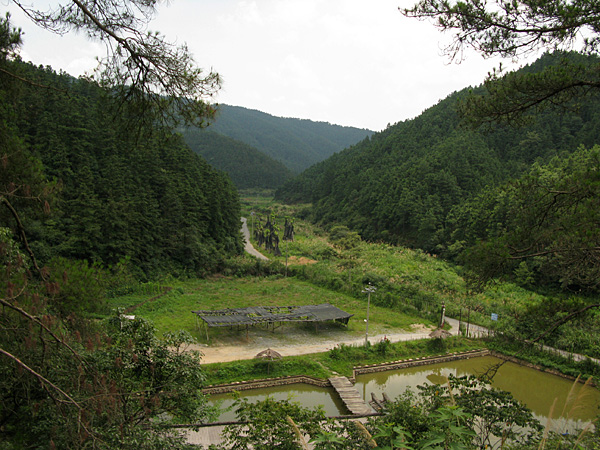
The Sanbao countryside
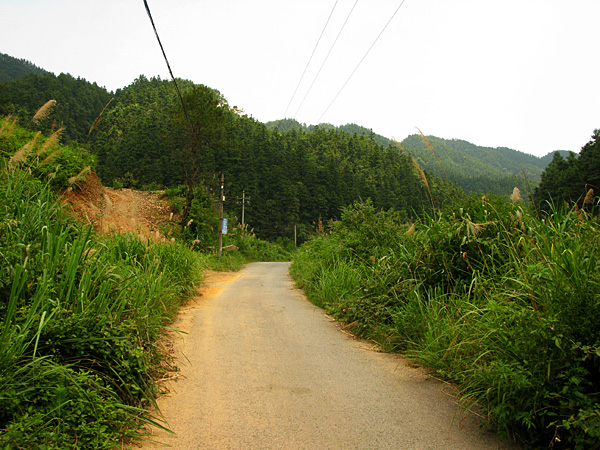
The road deeper into the mountains
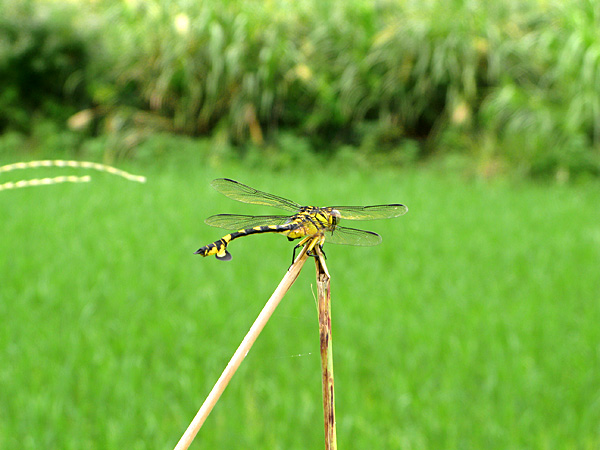
Yellow Dragonfly
Another amazing place is the San Bao Ceramic Village just outside of town near the base of the mountains. Patrick took us here for a delicious dinner, and it was so stunning that we had to go back to get a better look on Sunday. Their resident artists have studios that look out into the bamboo forest and hills beyond and it’s no wonder that they create such amazing work. They also have a small in for overnight visitors, and if we ever go back, we’re staying there. In San Bao, we seriously felt like we were back in Thailand (sans motorbike).
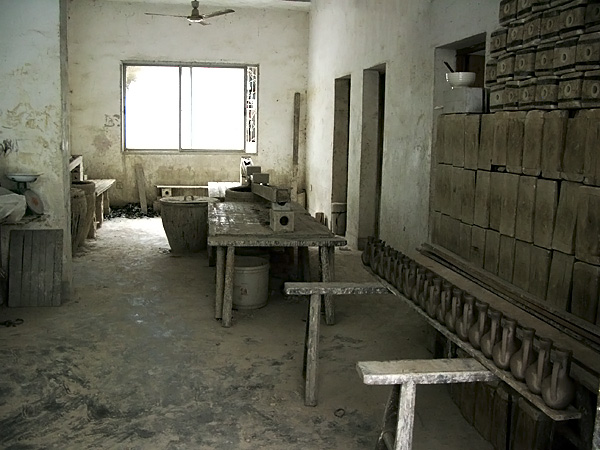
The workshop
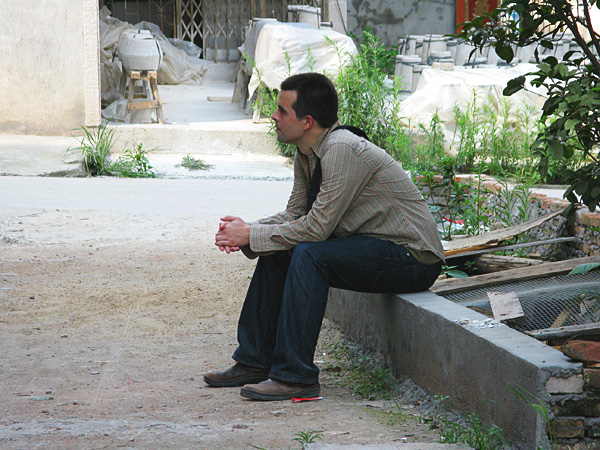
Relief from the sun
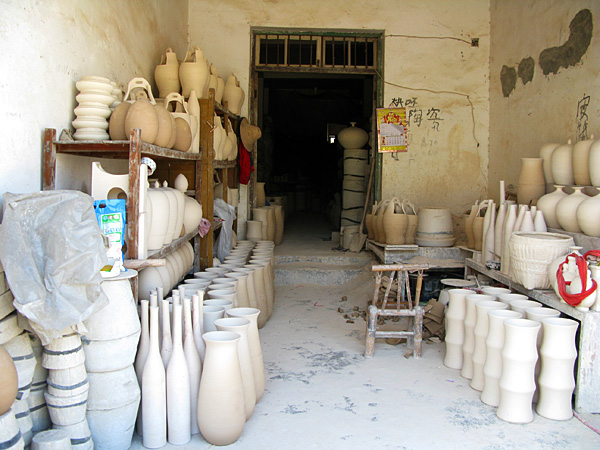
Another workshop
After we got the lay of the land from the Pottery Workshop guys, Nik and I headed out for the rest of the weekend to wander through the Lao Chang, Yu Zhou and Wei Min Ceramics Factories. When I heard “factory” I imagined huge buildings with people churning out pottery like machines, but the spaces are much more intimate than that. Granted, there are some big spaces and much of the work is like a machine, but a lot of it is done in the ground level of the artisan’s home. The work space is no larger than a small living room, and pots are overflowing into the sidewalks and street to dry or await transportation. Over the course of the weekend, we saw nearly every step of the ceramics making process, and that is how I’ve organized the rest of the photos. From dirt dug from the hillside to the final layer of glaze. I learned more about pottery this weekend by observing than I ever could have by reading books or listening to someone talk about it. Hopefully this new found appreciation will make its way into my own creative work….we’ll just have to see!
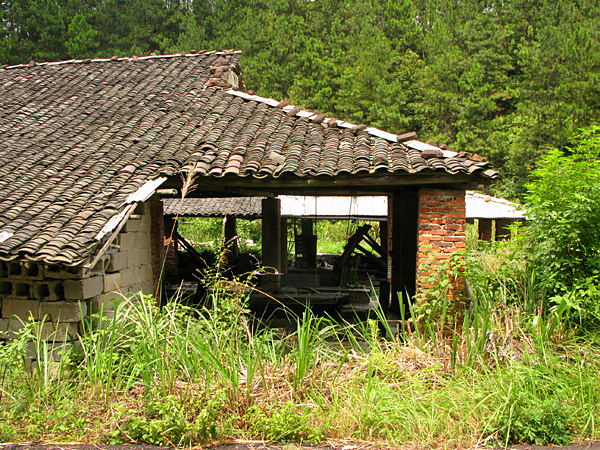
Clay bashing workshop
As you’re riding up the road past San Bao you hear a ‘bang bang bang bang bang’ in the distance, and as you get close to this clay tiled pavilion you see huge hammers going up and down in constant motion. This is where the raw stone is crushed, pressed and dried in preparation for the clay mixing factories closer to town.
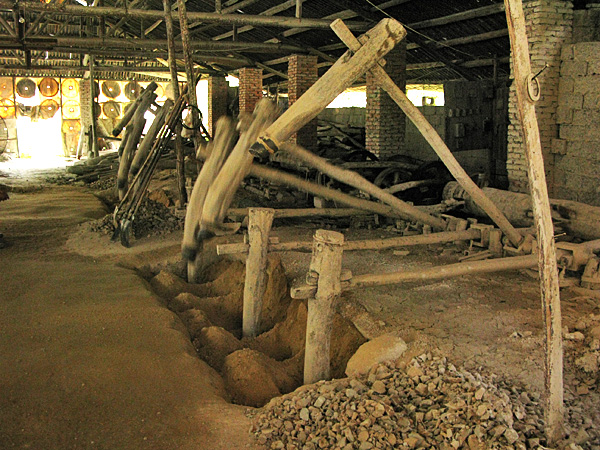
Clay hammers
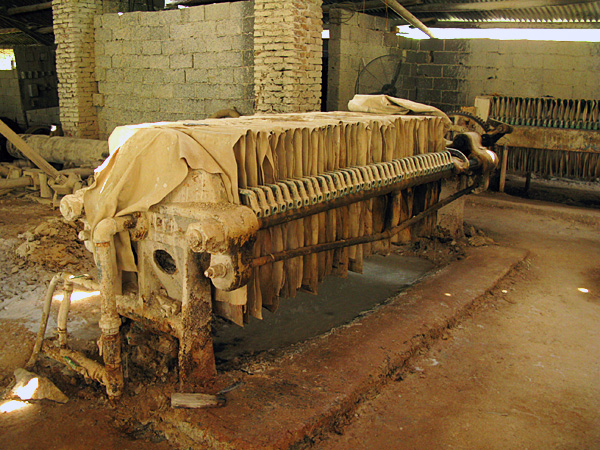
Clay compressor pressing out all of the extra moisture
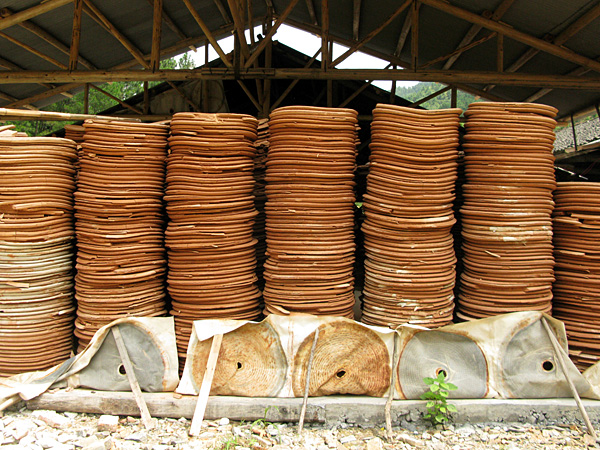
Pressed clay discs drying in the sun
The discs are then taken to factories where they are further ground and mixed with sand, water and other additives to produce the various porcelain clay bodies that the potters use.
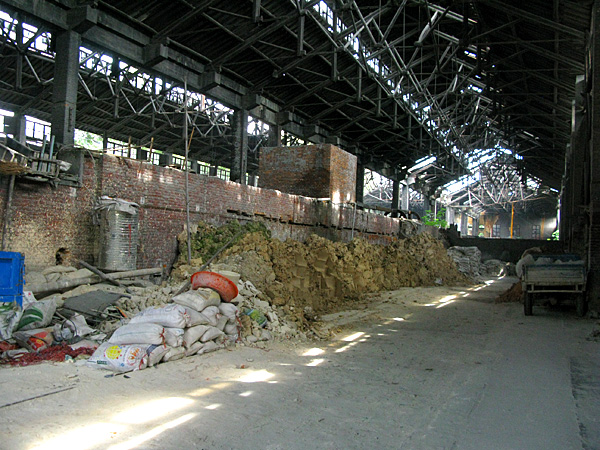
The Mix Factory
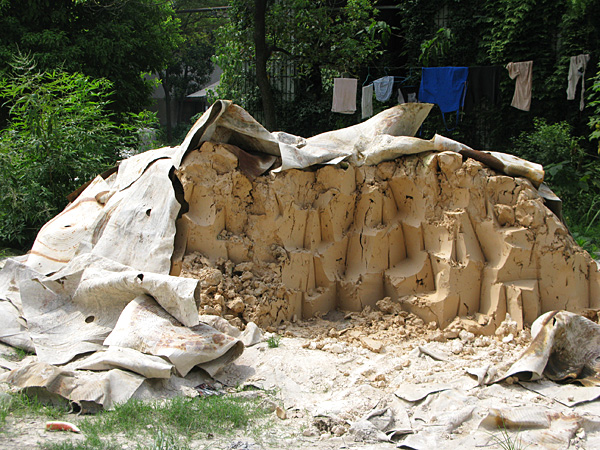
Stockpiles
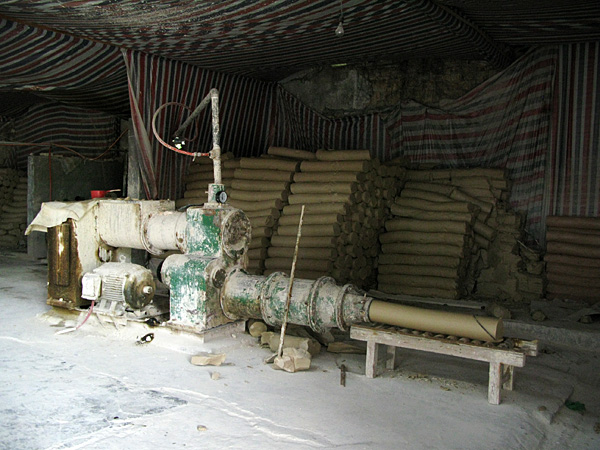
The extruder
The clay is then extruded into long cylinders and delivered to the artisans throughout town.
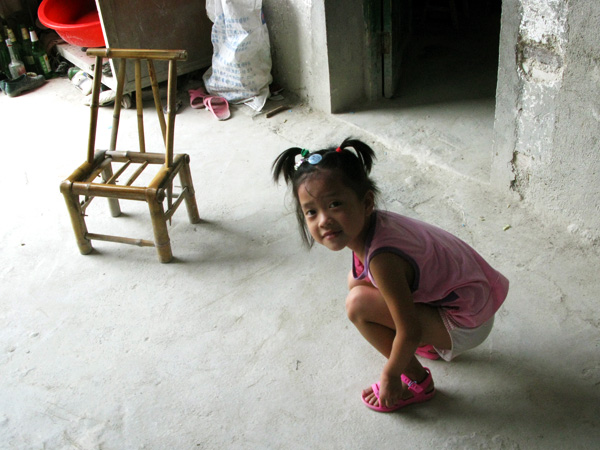
Pigtails
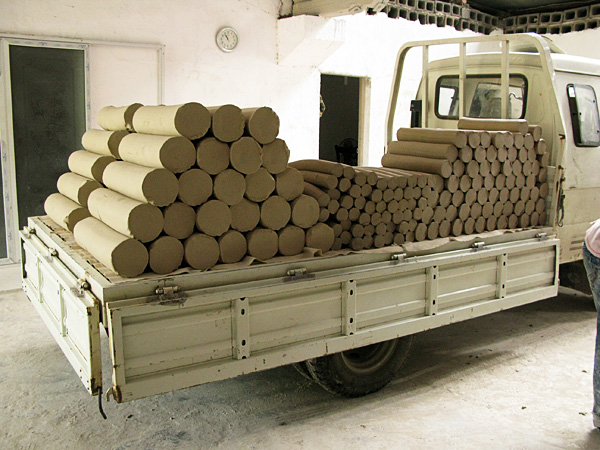
Extruded clay of all sizes
This is the step that gets confusing….sometimes the clay is taken to potters who hand throw vases, bowls and everything else on a wheel like the one below.
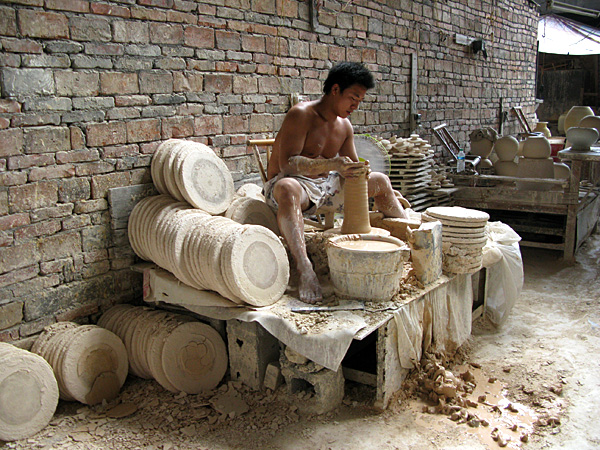
Throwing
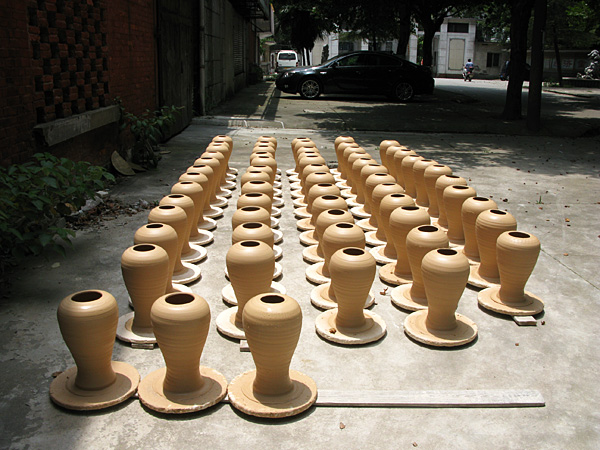
4 hours of work
Then the thrown pieces are dried in the sun and taken to the next shop where they are trimmed. Sometimes they are so large, two trimmers have to work in tandem. One actually trimming while the other scoops up the shredded clay and dumping it into the huge pile to the left.
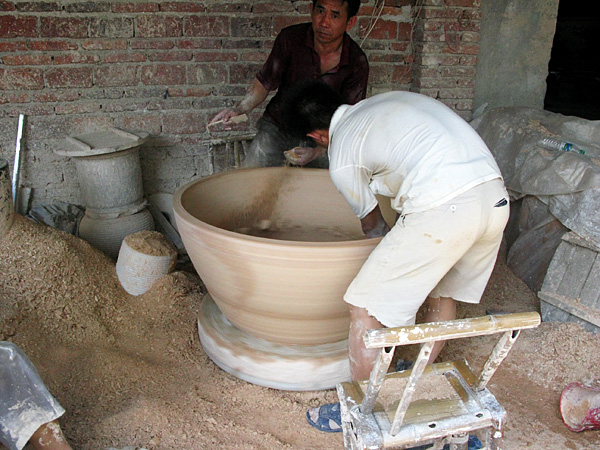
2-man Trimming
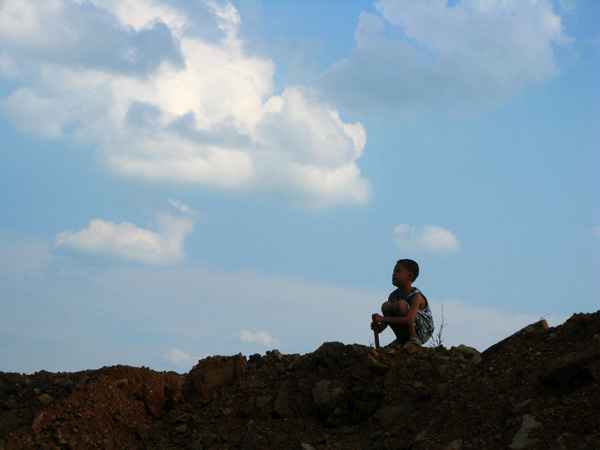
Little Boy in Thought
Then other times, the clay is taken to a shop that uses the slip casting method of making pots.
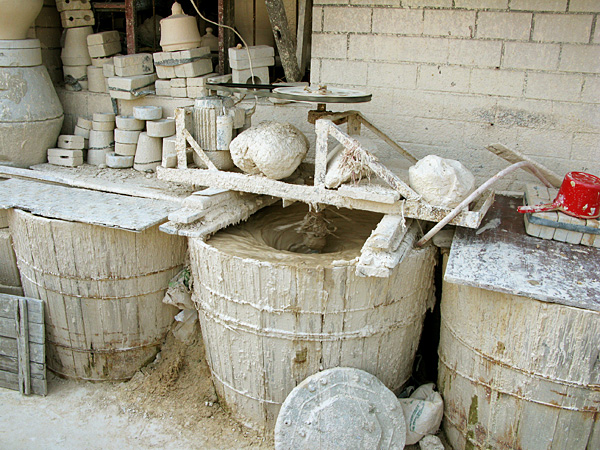
Slip mixing
First the clay is mixed with water to make a runny mud like liquid.
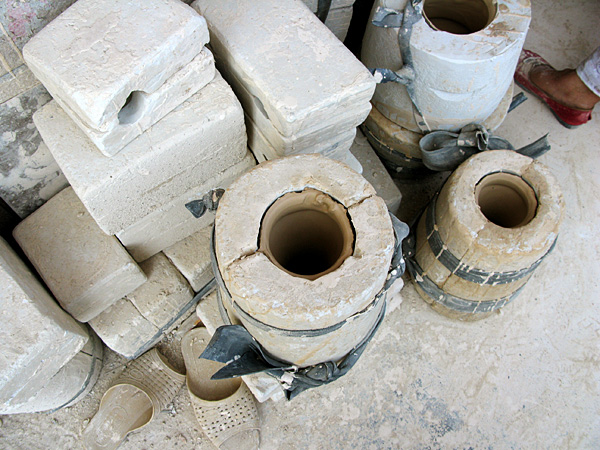
Freshly poured Slipcast mold
Then it is poured into a plaster mold where the moisture is sucked from of the outer centimeter or so of clay while the excess slip is dumped out. Then the molds are removed and the pots are left outside to dry.
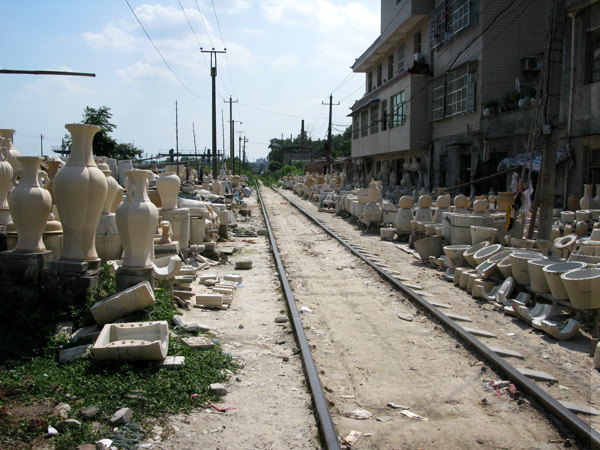
Train tracks lined with plaster molds and slipcast pots
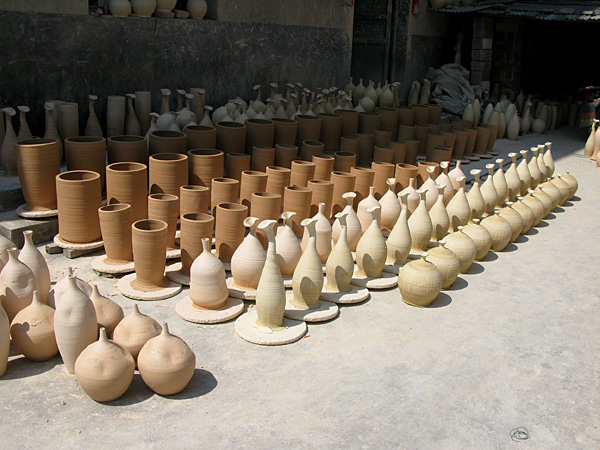
Drying in the Sun
Then the slipcast pieces are trimmed, pieced together and even carved into like the man is doing below.
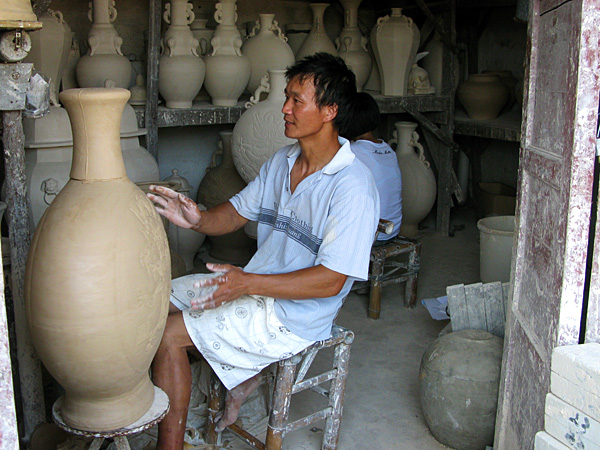
Carving
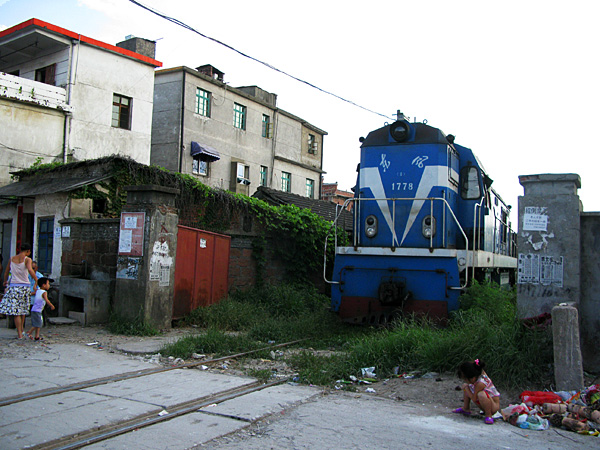
Train crossing/village outhouse
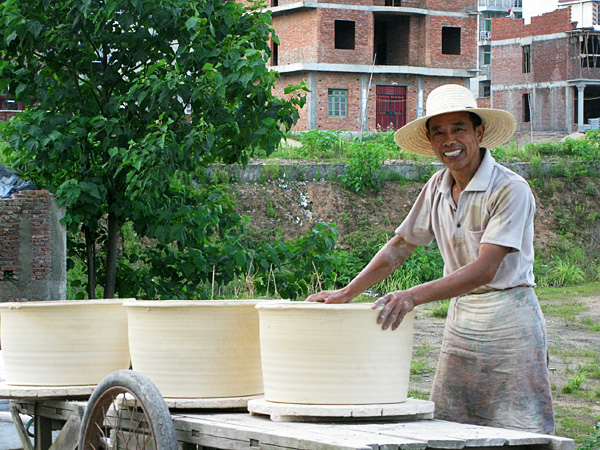
Loading up
Then the pots move on to factories and studios where the glaze is applied by hand. Sometimes the detailed illustrations are done by hand by painting glaze on top or etching a layer of glaze away. Sometimes the illustrations are cobalt decals that are placed on the piece like stickers and transferred by soaking it with water. Sometimes it’s a little bit of each.
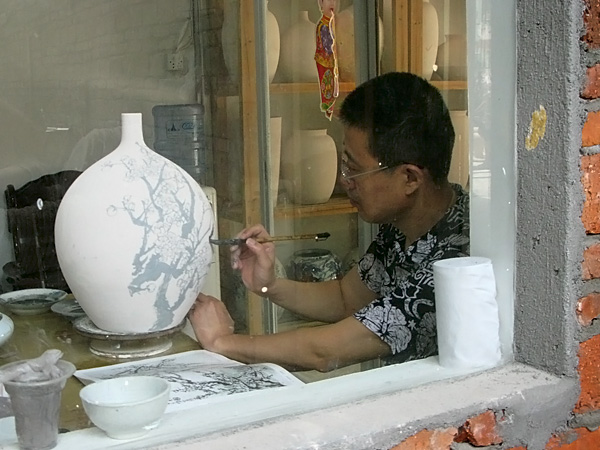
Master Painters
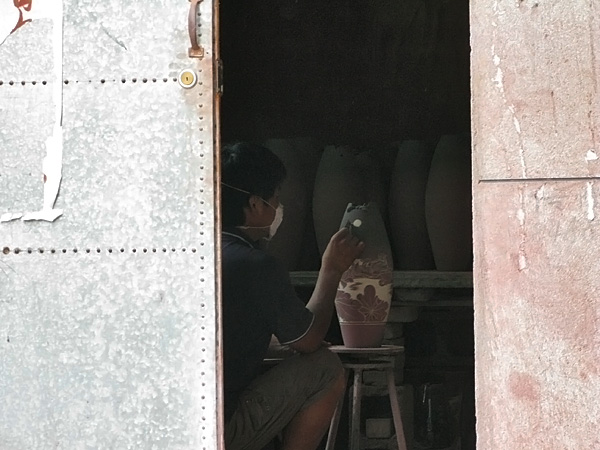
Glaze etching
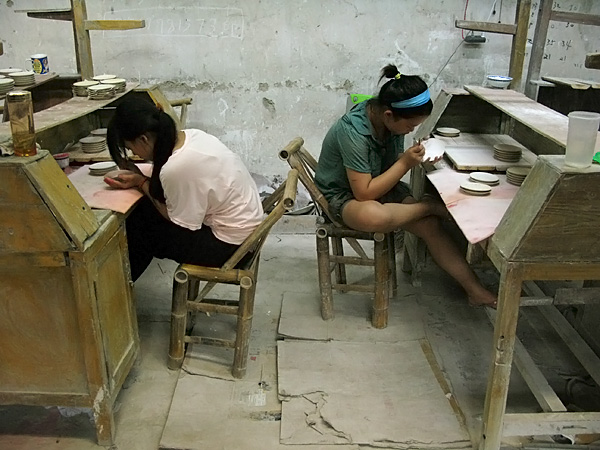
Hand painting
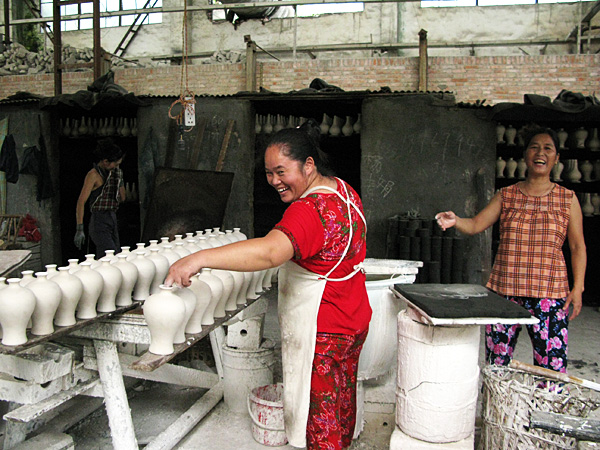
The happiest ladies in town
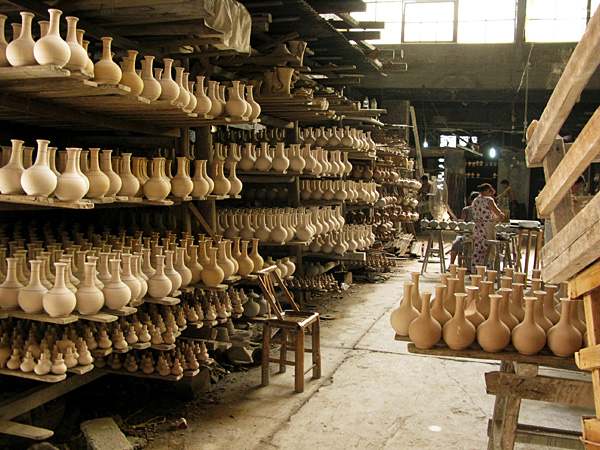
Factory Shelves
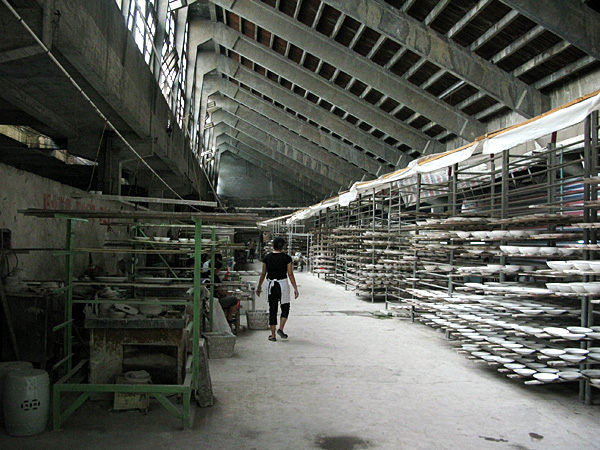
Decal Factory
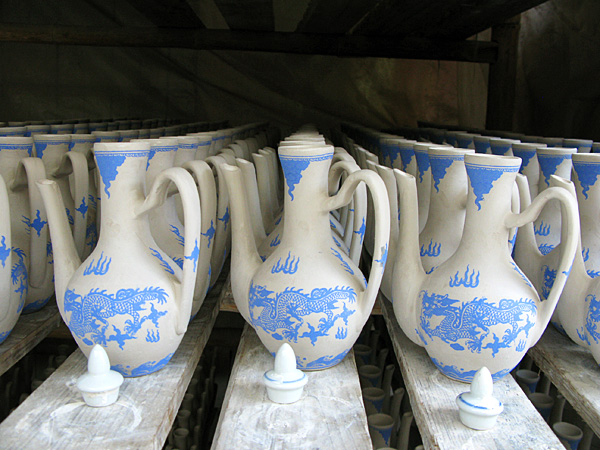
Teapot Decals
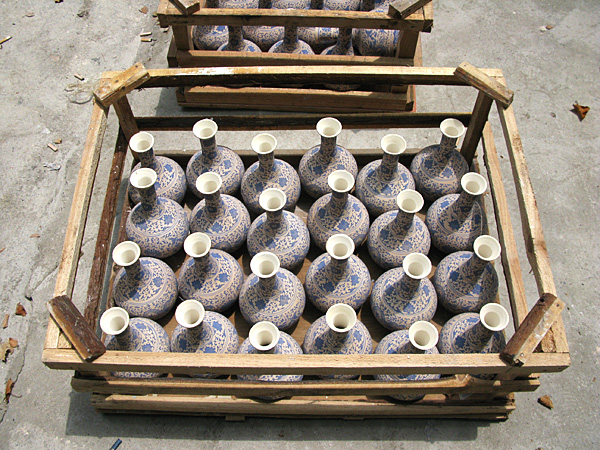
Crated and ready for transport to the kiln
The next and often final step is the actual kiln firing. In Jingdezhen, most pieces are only fired once which I didn’t even know was possible. I thought you had to bisque fire first to extract all of the moisture from the piece, then glaze it and fire it again in order to set the glaze. Perhaps that is just for stoneware??? But porcelain is okay to only fire once??? I’m still a little unsure of this step.
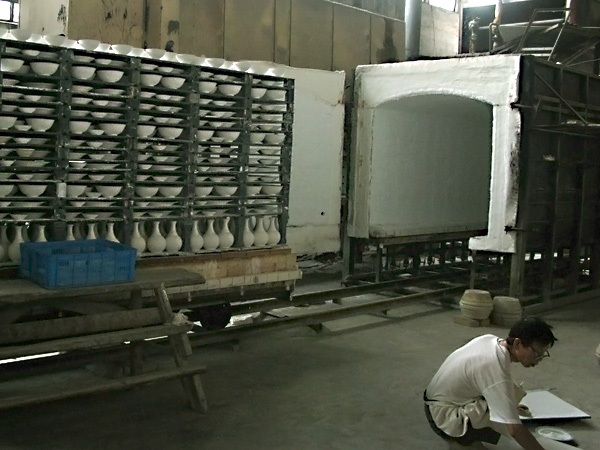
Loading the kiln
Once the firing is complete, the base of each pot is sanded by hand and checked for defects.
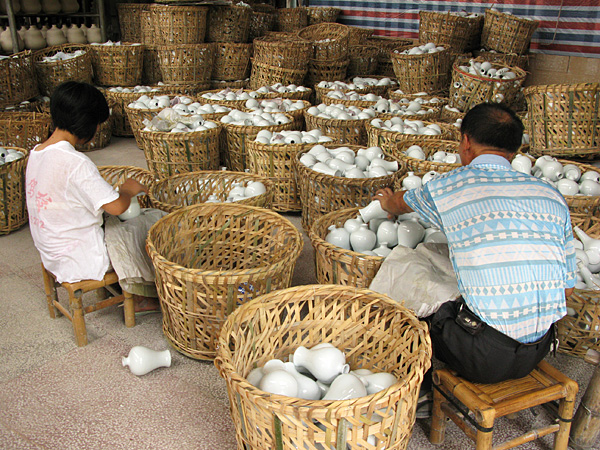
Final Grinding
And sometimes, factories close down and leave all of their plates outside to create the feeling of a porcelain graveyard. Eventually these plates will decompose and the minerals will seep back into the ground and become the original rocks that are hammered out in San Bao….maybe that’s stretching the whole circle of life thing a little too far.
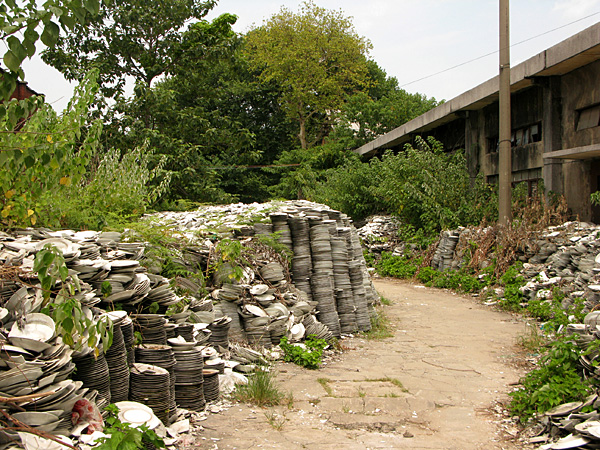
Porcelain Graveyard
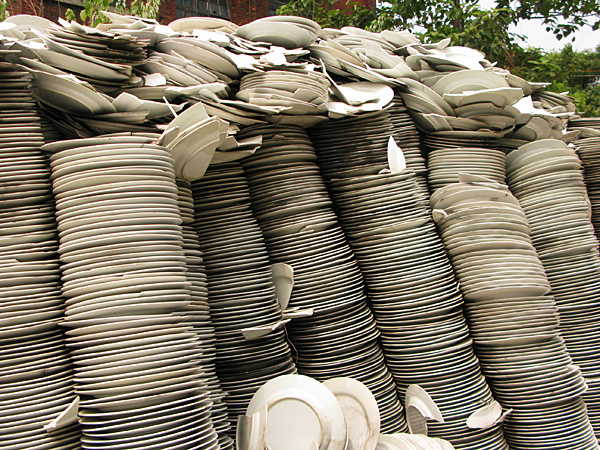
I wonder how many thousands of plates are here???
Our weekend in Jingdezhen was amazing, and it has taken me forever to write this post because there is so much to tell. In fact, I haven’t even told about half of the things we saw. My biggest regret is that we never went to the areas of town where the finished pieces were being sold. It would have been nice to see the final products, but Nik and I agreed that it was the process that we couldn’t see anywhere else in the world, so that was our focus. We wanted to see pots being made, and that is exactly what we saw. I did walk away with a set of 10 blue soup bowls with blue traditional decals, but I know there are pieces that represent the craft and beauty of the process much better. Oh well!
As always, Nik has some amazing photos and a much funnier and more coherent story of the weekend on his blog:
Jingdezhen Weekend Part 1: Saturday
Jingdezhen Weekend Part 2: Sunday
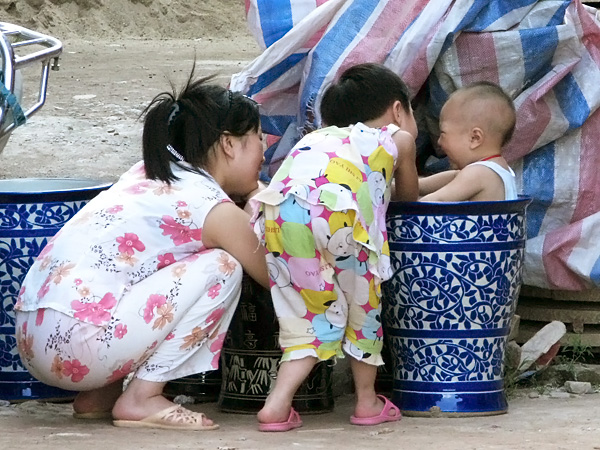
The perfect pot to store your child in
